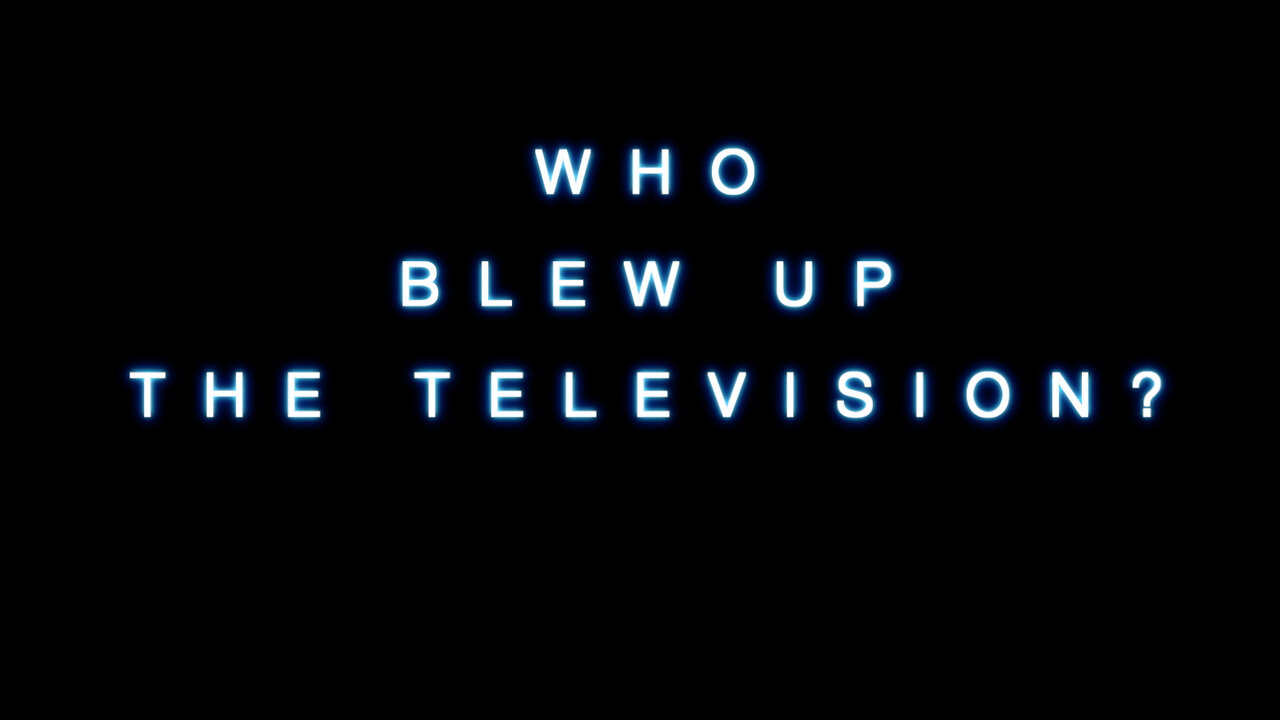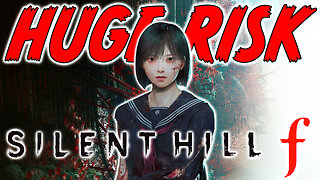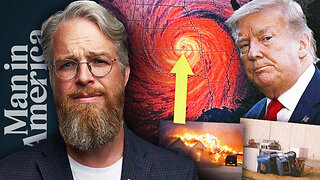Premium Only Content

WHO Blew Up the Television?!
Today’s story is about the loudest rock band in the world, a pair of folk-singing super-straight-looking siblings from Connecticut, and a shrapnel-producing, hair-singeing, ear-ringing explosion on live television that shockingly introduced America to an instrument-smashing English band who managed in their very first appearance, to blow a major television network right off the air.
All this mayhem took place in 1967, when television was mostly about escapism – Gilligan’s Island, F-Troop, The Green Hornet, Time Tunnel, Flipper, Green Acers & The Beverly Hillbillies.
Somehow, a pair of innoculous-looking brothers were offered their own variety show on National television. The catch? They would be going up against the competition-smashing juggernaut TV show, Bonanza.
Initially left alone by the network, the Smothers brothers slowly crafted a ground-breakingly controversial television show featuring brilliantly cutting-edge writers – including Mason Williams (who later wrote and performed Classical Gas, Bob Eisenstein (later, Super Dave Osborne), Steve Martin and Rob Reiner (Meathead on All in the Family and director of a bunch of major movie hits.
The Smothers Brothers Comedy Hour eventually succumbed to the pressures of Network censorship and the series itself ended with a bang – as CBS abruptly fired the brothers - having had enough of their irreverent and politically incorrect humour. The brothers immediately – and successfully sued the network.
But before the series was cancelled, it managed to leave its mark on the hearts, minds and ears of the American public.
The Smothers Brothers featured the some of the hippest new musical acts of the day – Ike & Tina Turner, George Harrison, Stepphenwolf, Jefferson Airplane, Buffalo Springfield, Harry Neilsen, The Temptations, The Turtles, … and for the American audience perspective, the introduction of an almost completely unknown scruffy British band called, The Who.
BAND BEGINNINGS
Formed in 1964, The Who are now considered the godfathers of punk, the pioneers of rock opera, and one of the very first groups to creatively integrate synthesizers into rock and roll.
The Who already had a reputation for not only producing incredible records but also for having an incendiary live show. In fact they’ve been described as one of the most electrifying physical live acts of all time.
And once they discovered Marshall amps – they became known as world’s loudest rock band – at one time even holding the Guinness Book World Record for performing the loudest concert in the world – in a London stadium.
- You had tough guy front man Roger Daltrey’s spinning his microphone and belting out powerful vocals .
- Artistic Pete Townshend’s lyrics with a guitar that spewed teen anger.
- Strong, silent John Entwistle – also known as The Ox - thumping out a loud and impressive bass noise with what looked like minimal – almost stoic – effort.
- And then finally, you had the heroic, tragic, magnificent and silly Keith moon – “the loon” – who took drumming and rock & roll craziness - to a whole new level.
Roger Daltry was born in a V1 rocket raid, near the end of World War 2. His mother said that next morning, half the street was gone. It was into that backdrop that The Who, The Beatles, The Stones and other British groups grew up.
And as far as the band itself went, Daltry said, “it was a very volatile group of people ... more like a gang.”
Townsend says when Daltry invited him to join the band, “it was the greatest moment of my life. I’ve despised him ever since”.
Pete by the way, had seen Keith Richards swinging his guitar arm and that gave him the inspiration to become king of the windmill-arm guitar playing style.
Pete was once pontificating to the press about the grandeur of rock, and said, “It’s the absolute, ultimate vehicle for self destruction. There’s nothing as effective.”
Pete has called himself a mystical frustrated seeker. He called what The Who did, "Power Pop" - at least before it got even angrier with songs like “I Can See for Miles” (and if you want to hear a really angry guitar, check out a later Townsend solo track called “Secondhand Love”.
Over the years Pete Townsend proved himself equally capable of writing tight, catchy 3 minute hit singles all the way up to full-on rock operas like “Tommy” and Quadrophenia.
But their first single to really go anywhere was, “Can’t Explain” in 1965.
Townshend said the song had a similarity to the Kinks hit, "All Day and All of the Night".
For the recording, their record producer brought in a vocal group called ‘The Ivy League’ to handle the backing vocals – finding the guys in the Who lacked the finesse he was looking for.
Bringing in professional substitutes was the style of many producers at the time. In the case of The Beatles, George Martin didn’t think drummer Pete Best was up to snuff for their first single – Love Me Do, so The Beatles fired Pete Best and brought in Ringo, but George Martin was also unhappy with Ringo’s “unsteady drumming.” Ringo was reduced to shaking a tambourine for the session, something he said took him years to forgive George Martin for.
In the case of The Who’s first single, the producer also tried to bring in a replacement drummer, but Keith Moon threatened to kill him if he didn’t take his equipment and get out.
And most famously - and before Led Zeppelin had formed – the producer also brought in session guitarist, Jimmy Page. Much has been made of Page’s contribution to the Who’s breakout song. He’s an accredited backing session player, confirmed by the band to have played rhythm guitar behind Pete Townshend’s slashing riff. Page has said the session easily could have gone off without him. “I didn’t need to be there,” Page later told Rolling Stone. “I was just playing rhythm guitar in the background," But the main riff, he confirmed, "was all Pete… He was roaring, man."
UK rock fans pushed ‘Can’t Explain’ up the singles charts to No. 8, and the band was officially on its way.
They followed it up with "Anyway, Anyhow, Anywhere" also in 1965, and it too went into the top 10 in the UK. Composed by Roger Daltrey and Pete Townshend, it was the only time they wrote together. The guitar feedback - although not the first to be heard on a record (The Beatles' "I Feel Fine" takes that credit), it’ s thought to be the first guitar solo with feedback.
Their next single was ‘My Generation’ also released in 1965.
It features one of the most iconic rock lines of all time,
“Hope I die before I get old”.
The story goes that a young, fresh, hip, Pete was driving his brand new Lincoln Continental through a posh part of town and a sophisticated older London woman sneered at him from her car as he cruised by. Townsend says “Hope I die before I get old” - is about everything she represented to him.
Another version of the story says that Pete was inspired by the Queen Mother, who allegedly had Townshend's 1935 Packard hearse towed off a street in Belgravia because she was offended by the sight of it during her daily drive through the neighbourhood.
Daltrey delivers ‘My Generation’ with explosive anger and a frustrated stutter. Various stories exist as to the reason for this distinct delivery. Some say it was to mimic the sound of a British mod on amphetamines (speed).
But their producer insisted that it was simply "one of those happy accidents" in the studio that he thought they should keep.
Daltrey has also commented that he hadn’t rehearsed the song prior to the recording, that he was nervous, and that he was unable to hear his own voice through the monitors. The stutter came about as he tried to fit the lyrics to the music as best he could, and the band decided it worked well enough to keep. The BBC initially refused to play "My Generation" because they didn’t want to offend people who stuttered, but they reversed their decision after the song started climbing the charts.
The stuttering also allowed Daltry to imply some swearing during their live shows, "Why don't you all just fff ... fade away!"
"My Generation" also featured one of the very first bass solos in rock history.
“My Generation” has been named ‘the 11th greatest song rock song of all time’ by Rolling Stone Magazine on its list of the 500 Greatest Songs of All Time.
It’s interesting to note that the man who wrote the lyric ‘hope I die before I get old’, when he reached 30, wrote the lyrics: “Goodbye all you punks. Stay young and stay high. Hand me my check book and I’ll crawl out to die.”
SMASHING GEAR
As The Who was gaining a reputation as one of the most physically electrifying and ear-splitting live acts, they also became known for their ground-breaking practice of destroying their instruments on stage.
Pete Townshend said it was an accident the first time he smashed his guitar. The Who were playing in a small cramped room in west London. The ceiling was damp with condensation, the room was smoky, and smelled of sweat and stale beer. While they were playing … Pete says …”I began to scrape my howling Rickenbacker guitar up and down my microphone stand and as I violently thrust my guitar up into the air—I feel a terrible shudder as the sound goes from a roar to a rattling growl; I look up to see my guitar’s broken head as I pull it away from the hole I’ve just punched in the low ceiling. It is at this moment that I make a split-second decision—and in a mad frenzy I thrust the damaged guitar up into the ceiling over and over again. What had been a clean break becomes a splintered mess. I hold the guitar up to the crowd triumphantly. I haven’t smashed it: I’ve sculpted it for them. I throw the shattered guitar carelessly to the ground, pick up my brand-new Rickenbacker twelve-string and continue the show…. One rule for remaining cool. Always make your mistakes look as if you meant to do them all along.
Rolling Stone magazine considered the event so important that it has been included in their list of “50 Moments That Changed Rock & Roll”.
So that’s where the boys were at when it came time to make their US television debut.
THE SMOTHERS BROTHERS SHOW
Meanwhile, a clean-cut innocuous looking set of folk-singing brothers had just been offered their own variety show on the CBC television network – and especially big deal as their were only three major American networks at the time. The show started off very non controversial – as the non-threatening, Ivy league-looking boys next door jumped into a suicide spot as a midseason replacement to desperately take on the competition-destroying juggernaut - Bonanza. Half a dozen shows had already crumbled and disappeared in this timeslot so the network felt it had nothing to lose by giving the Smothers Brothers a go.
They never used a laugh track – preferring to get 100% genuine audience reaction. In its day, The Smothers Brothers Comedy Hour was the pop culture equivalent of Saturday Night Live.
New and innovative performers like Jimi Hendrix , Donovan, Buffalo Springfield, Harry Neilson, Ike & Tina Turner, Paul Revere and the Raiders, Kenny Rogers and the First Edition, Steppenwolf, The Byrds, The Temptations, The Turtles, Jefferson Airplane, and The Doors - to name but a famous few – were introduced to brand-new audiences during the Smothers Brothers Sunday night time slot. The Beatles even debuted their exclusive U.S. videotape premiere of “Hey Jude” on the show.
Now CBS TV had thought they were getting an old-school variety show when they added 'The Smothers Brothers Comedy Hour' to their arsenal. Instead, they wound up with the most cutting-edge TV series to date, riding the edge of the countercultural and political zeitgeist with incisive jabs at the latest news and with appearances by some of the coolest musical acts of the day.
The Smothers brothers material became more and more brazen and politically volatile, resulting in constant fights with network censors.
They were even censored by censors for a doing a sketch on censorship.
Eventually, when the CBS Network executives had had enough, they angrily fired the Smothers Brothers and yanked the show off the air, mid-season. It’s of note that the brothers later sued the network – and won.
But back to that night in September, 1967.
THE PERFORMANCE
They say you never get a second chance to make a first impression.
Planned or not, Keith Moon was going to make sure that nobody watching The Who’s US television debut would ever forget the moment. The moment they blew up the television and temporarily brought down CBS.
When they were booked for their appearance, they’d just notched their first U.S. Top 10, “I Can See for Miles.” They performed that single earlier in the show and ended with “My Generation.”
The legendary drummer Keith Moon had taken to filling his bass drums with flash powder to create a loud noise and bright flash - adding to the instrument-smashing mayhem the rest of the band members had come to finish their shows with.
Kieth had already become known as Moon the Loon, a crazy man – to say the least. Some of the things he did over his career included driving his Lincoln Continental into a swimming pool on his 21st birthday, nailing his hotel room furniture to the ceiling – which earned the band a lifetime ban from the Holiday Inn chain, and chasing Townshend through a train car while wielding a knife. On stage one evening, Pete was pissed at Roger for something and swung his guitar at Daltrey – just grazing his arm. Former street fighter Keith punched Townsend in the nose, knocking him out cold on stage.
Even Keith Moon’s neighbor - Steve McQueen was fair game. McQueen had just starred as a prisoner in “The Great Escape” and Moon would often march past McQueen’s house dressed as a Nazi.
One time Moon took horse tranquilizers just before a show and then passed-out over his drums, mid-set in San Francisco. A drummer was recruited from the audience to finish the show.
“I really admire their stamina”, the guy said later. "I only played three songs and I was completely exhausted."
In Montreal, they trashed their hotel so badly that they were thrown in jail for a night and they earned a lifetime ban from the Holiday Inn chain.
So hiding extra explosives in his drum kit was par for the course for Moon.
Now some say that Keith had gotten the stagehand drunk during the afternoon - bribing him with shots of brandy to add an extra charge and give things an extra kick. And Keith may have added even more himself – on top of what the stagehand had done. All of this was set up without the rest of the band having any clue.
Some reports say they’d packed in three times the normal amount of explosives; others say it was more like 10 times the amount he normally used to close out Who shows. Either way, it took the network, the audience, the Smothers Brothers, and even The Who themselves, by complete surprise.
When Tommy Smothers introduced the group, he said the audience "was going to be surprised what happens.” They were. And he was too.
Townshend nearly took the blast straight to his head. As he emerges from the cloud of smoke, you can see him patting down his hair to make sure it wasn’t on fire. He recalled, “It set my hair alight,” and he would later say the explosion was a factor in his future hearing loss.
Keith Moon can be seen launching off his perch, grabbing his arm and rolling around in pain as he reportedly received shrapnel injuries to his arm from an exploded cymbal.
As confusion reigned, Tommy even got into the fun, his mouth agape with shock as Pete awkwardly removed Tommy’s acoustic guitar and smashed it to bits. Tommy finished the segment with, “Hey Dick,” he said to his brother, “I’d like to borrow your bass for a minute.”
And if that wasn’t enough, just slightly off stage and waiting to go on next, was screen legend Bette Davis, who reportedly fainted when she saw the blast.
The velocity of the flash even knocked out the studio cameras for a moment – taking the network temporarily off the air. It became one of the most seminal moments in rock and roll history and saw The Who become household names overnight.
-
 4:55
4:55
AmplifiedLIFE
2 months agoPredictions for 2025 & Beyond from Beyond
1023 -
 24:19
24:19
marcushouse
7 hours ago $1.18 earnedWhy Is Starship So Difficult to Get Right?
18.5K3 -
 13:22
13:22
Degenerate Jay
1 day ago $8.06 earnedSilent Hill F Looks Amazing - Is This The Future Of Silent Hill?
50.3K9 -
 19:29
19:29
Clownfish TV
1 day agoGamers Blamed for DOGE.
26.3K36 -
 11:47
11:47
Tactical Considerations
15 hours ago $6.13 earnedAB Suppressors Ribbed For Silence..
42.1K1 -
 15:08
15:08
NinjaGamblers
20 hours ago $1.38 earnedAggressive Fisher's Method at Roulette: How to Win $600 in an Hour
15.8K12 -
 1:12:44
1:12:44
TheDozenPodcast
20 hours agoTerrorist MACHETE attack left me for dead: Tal Hartuv
32.4K15 -
 6:06
6:06
scoutthedoggie
1 day agoAirsoft Warfare Scotland
19.8K3 -
 6:15:31
6:15:31
SpartakusLIVE
15 hours ago#1 BIG BRAIN releases the FULL POWER of his CEREBRAL DOMINANCE
138K10 -
 57:19
57:19
Man in America
23 hours ago🚨 Disaster Expert: Weather Warfare Hasn't Stopped Under Trump—Are You Ready for What's Coming?
85.4K172